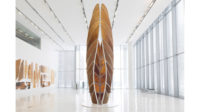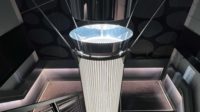Editor's Note: In response to the COVID-19 outbreak, this exhibition is available online beginning May 14. For updates, visit moma.org.
Architecture is by nature transdisciplinary, encompassing art and engineering. But the work of Neri Oxman, founder of the Mediated Matter Group at the MIT Media Lab, takes this integration to an extraordinary level. The investigations of the polymath Oxman, who studied medicine before switching to architecture, fuse biology, computation, and digital manufacturing to propose new ideas for materials, objects, and buildings. A selection of the projects created over the course of her 20-year career are on view in the thought-provoking Neri Oxman: Material Ecology at New York’s Museum of Modern Art (MoMA).
The centerpiece of the exhibition, organized by MoMA senior curator Paola Antonelli, is Silk Pavilion II, a tensile shelter that extends from floor to ceiling in a 26-foot-high gallery on the street level of the newly expanded museum. The pavilion’s translucent skin was spun by 17,000 silk worms. But instead of relying on traditional silk-harvesting methods, which entail boiling cocoons, and therefore killing the larvae, the piece was created with living insects. Oxman and her team developed a biological additive manufacturing process, using heat and light to influence silkworms to spin in sheets over a steel-cable armature.
The exhibition reveals Oxman’s interest in life—as well as its end—with a series of digitally fabricated works inspired by death masks and made of photopolymers richly hued with bismuth, silver, and gold. The show includes works where life-sustaining substances are deployed to help form structural frameworks, such as a group of column-like explorations which Oxman has dubbed Totems. At the center of each is a rectangular prism of clear resin that encloses a swirling form. This effect has been achieved through 3-D printing and by incorporating liquid melanin—a pigment that determines the color of hair, fur, skin, and eyes in millions of species and provides thermal regulation and defense against UV radiation. The accompanying wall text suggests that melanin someday could be used to produce responsive facades that vary with the time of day or the season.
Such a real-world application might sound speculative—at least in the near term. However, other pieces in the show seem eminently practical, especially Aguahoja, which proposes biodegradable alternatives to conventional plastics. The works combine substances such as cellulose—the basic structural component of plant cell walls—with generative design and digital fabrication, producing artifacts that recall veined leaves, diaphanous insect wings, and tree bark.
The Aguahoja series is arresting, as are almost all the objects in Material Ecology. But their appeal is more than merely formal. Taken together they present a strikingly optimistic vision of a future where seemingly intractable problems will be solved through the powerful combination of design, technology, and deep understanding of the natural world.





